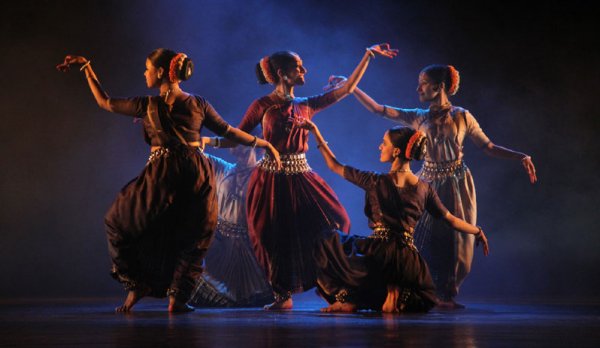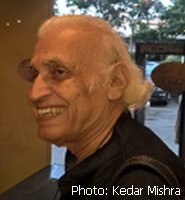
|   |

|   |
 e-mail: sunilkothari1933@gmail.com Madhavi Mudgal's choreographic works in Odissi Photos courtesy: Gandharva Vidyalaya November 10, 2017 Under the aegis of Rasaja Foundation, at IIC Fountain Lawns in Delhi, on a specially constructed stage, Madhavi Mudgal presented her disciples in group choreographic works in Odissi to the music composed by Madhup Mudgal. Few months ago, Madhavi had released DVDs of her group choreographies. Produced with excellent technical support these works are a commendable record of Madhavi's creative works along with Madhup's creative collaboration and melodious music. Some of these works were selected by Madhavi for presentation for Rasaja Foundation. Whereas the excerpts of the DVDs when screened had created a visual record with exquisite lighting and technical support for filming, the experience while watching the live performances was enjoyable on a different level. Gautam Bhattacharya, a long time associate of Madhavi, provided suffused lighting, painting as it were, the dancers in various hues and textures. The chiaroscuro effect, the light and shades playing upon the dancing bodies was interesting to look at. The recorded music of a very high standard almost gave a feeling of live music. The first number inspired from a shloka for Rangastuti, prayer for the Gods of the stage from Abhinaya Darpana was set to imaginative music, based on notes emanating from tanpura. It had an amazing effect of chanting. When dancers appeared positioned in different directions, few sitting, one standing with her back to the audience, the body outlined by soft lighting evoked auspicious feelings. The shloka with "Bharata kula bhagya kalike, bhava rasananda parinatakare, Jagatheka mohanakale, jaya jaya rangadhi devatedevi" stanza permeated the atmosphere. It hailed victory unto the presiding deities of the stage that fills the hearts of the audience with emotions and aesthetic delight. When the dancers brought in lamps and moved in circle and came together in a cluster it looked magical. The confluence of dance movements, music, and lighting was perfect. It set the tone for the other numbers to follow. Madhavi introduced the next work titled 'Tivra Madhyam'. How tradition is termed in Indian concept as parampara, providing possibilities of creative inputs, like a flowing stream, ever renewing itself, the swaras employed imaginatively, using various ragas with focus on one particular swara Tivra Madhyam, and the dance movements following them with various combinations and coming to the same point as Tivra Madhyam, offered the choreographer scope to explore various possibilities. The ragas Hindol, Vasant, Marva, Maru Bihag, Kalyan returned to Tivra Madhyam note as the dance moved, creating an unusual musical experience. The musical pattern was exquisite.  In terms of dance, five dancers appeared on stage forming a chain, moving arms alternately, moving in different directions, the innumerable sculptural poses fleeting, various geometrical patterns emerging, the basic stance of chowka performed repeatedly, with one arm, had excellent visual appeal. And whenever the circle was formed, at times dancers sitting and getting up, one could see the sheer beauty of dance. Dancers in a row looked like Devakanyas joyously dancing in group. Dancers holding potala hastas, moving in rhythm with waving of up and down movements of the arms created fascinating visuals. The coordination and synchronization of the movements and postures was perfect. After this sumptuous feast of music and pure dance, Madhavi presented a narrative number. It was suggested to her by poet Ramakant Rath. A story written in verse form by 16th century poet Gopinath Das set to traditional Odiya music by A. Maheshwara Das was edited by Madhavi for presentation. It deals with one young sister by name Tapoi, who has seven brothers and seven sisters-in-law. They belong to merchant class and have flourishing trade. They all live happily together. But once a Brahmin woman comes to see them and seeing them so happy succeeds in poisoning ears of the wives against the young sister Tapoi. Unfortuantely on account of financial reverses the seven brothers leave for earning abroad and entrust Tapoi to their wives to look after her. Meanwhile after being influenced by the Brahmin woman, the six wives, except the youngest admonish Tapoi and send her to graze the goats in the forest, where they hope Tapoi would meet with wild animals and maybe killed. But the youngest sister-in-law does not like that decision. The eldest sister-in-law threatens Tapoi that if her favourite goat is killed she would cut Tapoi's nose and punish her. Tapoi is much distressed. She awaits her brothers' return. When they return they ask for Tapoi and call her. She is overjoyed. When the brothers learn about the punishment meted to Tapoi, they ask the wives to offer salutations to Tapoi and ask her forgiveness and tell Tapoi to cut their noses. Tapoi does so except for the youngest sister-in-law who loved her. The story ends with Tapoi being united with her brothers. Madhavi has choreographed this story with a large number of her disciples. When all dancers assemble on the stage, each one comes forward and to the singing of the song tells the story. Later on different dancers play the roles of seven brothers and their wives and a young dancer that of Tapoi. When the brothers go for sea voyage, the sequence is imaginatively choreographed suggesting rowing of boat. When Tapoi is sent to forest, three dancers stand near each other with arms indicating branches. The serpent, crocodile and tiger with paws are enacted by dancers, near the trees. The narration is done in quick succession in typical Odiya tune. Dancers enact their roles as per the text. The performance runs smoothly. Barring several female dancers one young male dancer also performs in the group. The young dancer playing the role of Tapoi performed so well that it generated sympathy in the audience for her plight.  The final choreographic work was Pallavan. It was choreographed in 1995 exploring various elements of nritta. Using the dance units like karanas, angaharas and introducing tala and jatis, the panch nadais viz., nine, seven, five, four and three, the work develops like flowering of the leaves on branch of a tree–Pallavan. Various swaras are rendered and the hauntingly melodious notes Jham ta, jham ta, tari kukutari ta fill the air to which dancers perform in unison. The various patterns created by dancers covering space in different directions, few sliding away in the wings and then re-emerging and forming interesting groupings reveal the creative abilities of Madhavi offering audience glimpses into what beauty Odissi dance is capable of creating in pure dance. A prime disciple of Guru Kelucharan Mohapatra, Madhavi has scaled artistic heights in creating these works, extending the horizons of Odissi. The new generation learning and performing Odissi has in Madhavi an example of what one can do with the traditional form. Madhavi indeed is singularly fortunate in having in her brother Madhup Mudgal, a gifted musician, who along with her explores the Hindustani musical form for Odissi dance. In that sense, both Madhavi and Madhup have extended the frontiers of Odissi using Hindustani music to great advantage. As the Sanskrit saying goes, kshane kshane yam navatam upet, tadev rupa ramaniyataha. Each moment the dance invests itself with newness, there lies the beauty. Madhavi has succeeded in visualizing it in a most appealing manner. The music and dance go hand in hand, each enhancing the beauty of the other and with lighting, costumes with various shades of colour, adding to the total impact. It only whets the appetite for seeing it again and again. To Madhavi's credit it must be said that her disciples have excellent training under her and in terms of their physical looks and appearance, they create uniformity.  Dr. Sunil Kothari is a dance historian, scholar, author and critic, Padma Shri awardee and fellow, Sangeet Natak Akademi. Dance Critics' Association, New York, has honoured him with Lifetime Achievement award. Post your comments Please provide your name and email id when you use the Anonymous profile in the blog to post a comment. All appropriate comments posted with name & email id in the blog will also be featured in the site. |